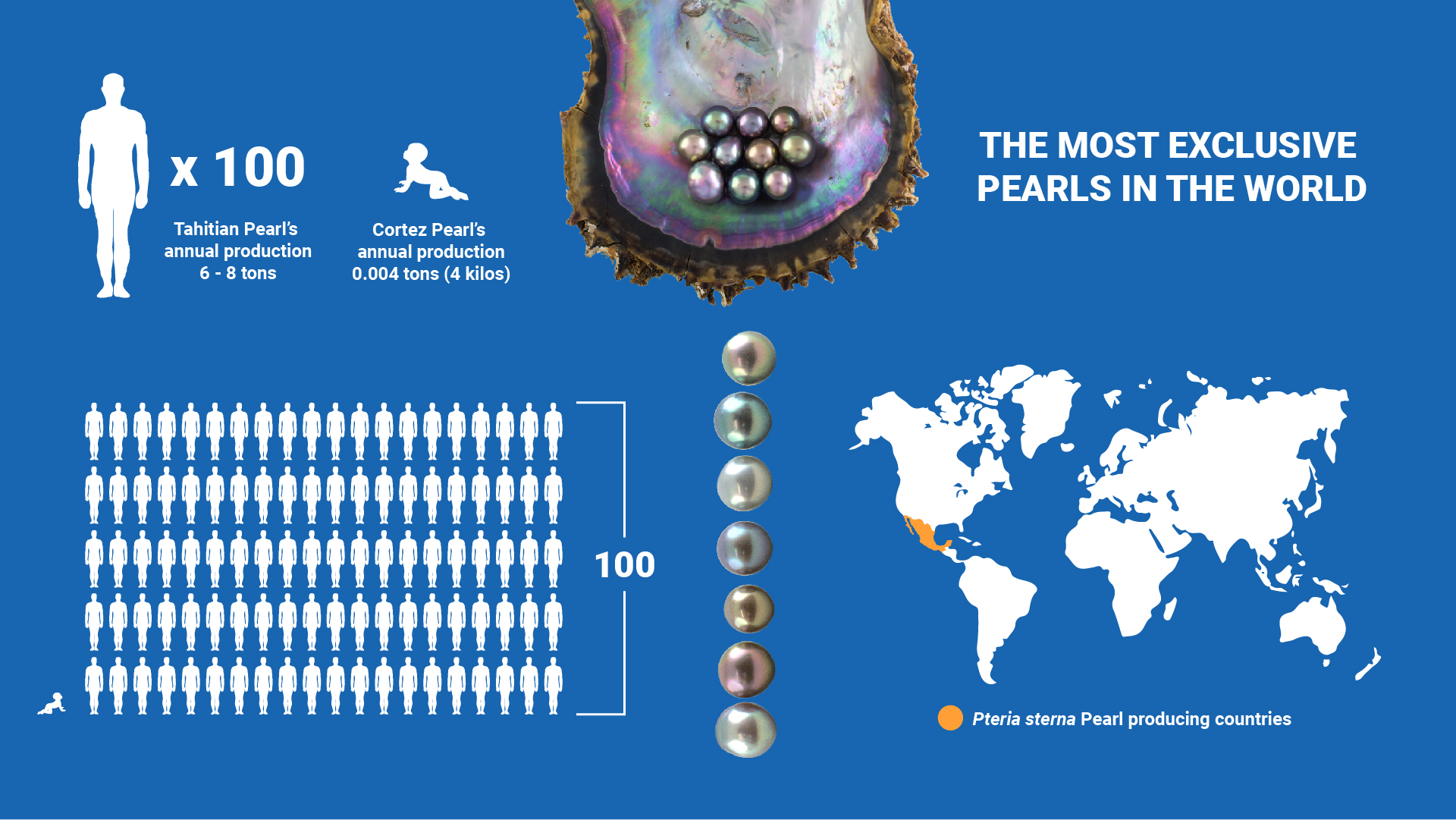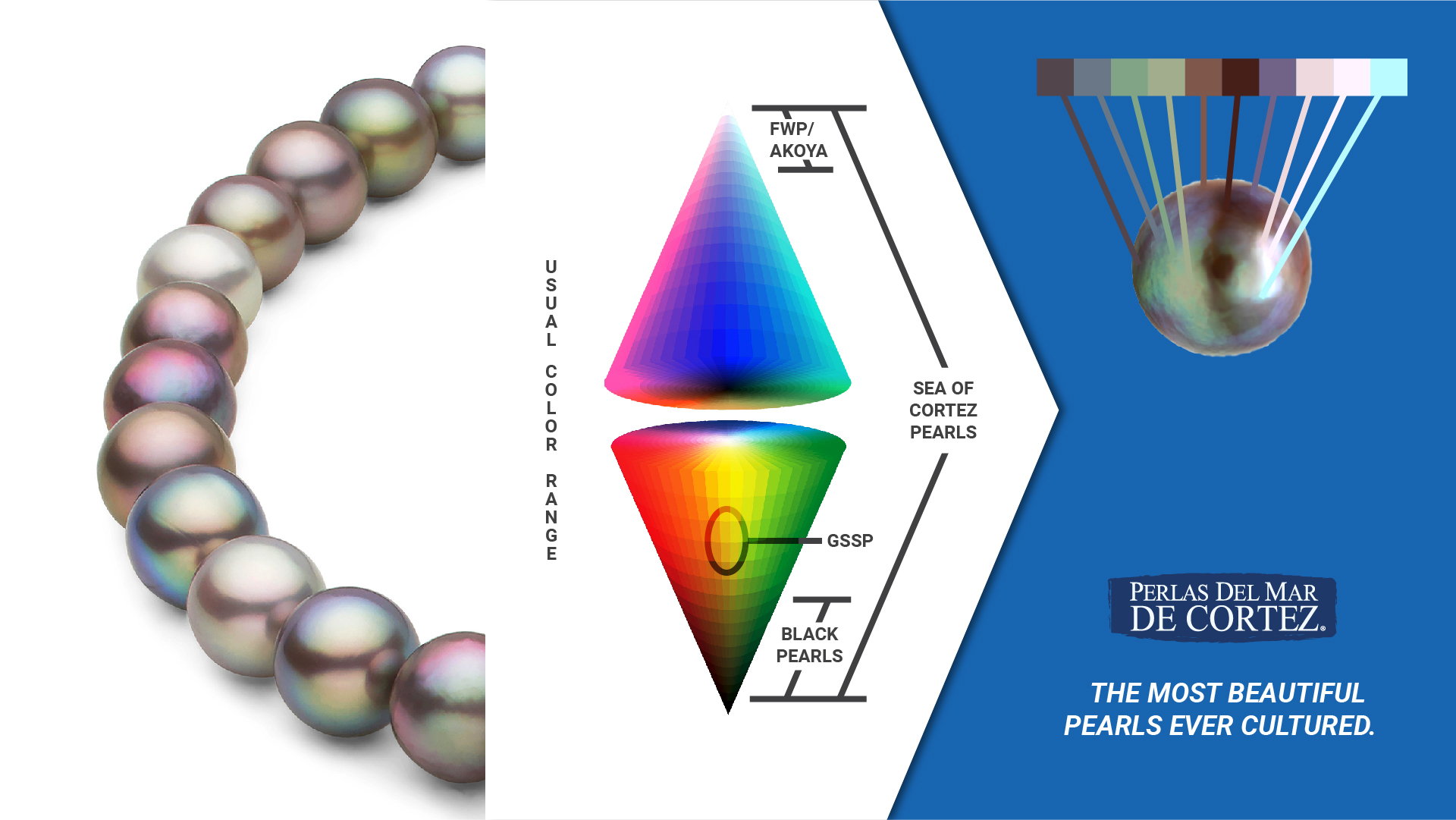Farming
Growing the Cortez Pearls is a fascinating activity which requires a lot of patience since the whole cycle can take up to four years. First, we invite you to see our short video which summarizes the whole procedure.
Play Video
01
Pearl Oyster farming begins in the reproductive season when both sexes release their gametes into the surrounding waters so that the eggs are fertilized giving way to the formation of the microscopic larvae which remain floating as part of the plankton until they find a good place to settle down. We provide them with a substrate which they find attractive, the “collector bag”. Once they settle and start producing a hard shell, they become juveniles.
These juveniles are placed inside a protective culture cage known as “Pearl Net”. These are our nursery nets; they have a pyramid shape and a very narrow mesh in order to protect the young pearl oysters, which still have a fragile shell, from predators. Studies have shown that out of every million pearl oysters born in the wild, only from one to ten will survive to adulthood. But, thanks to the protection of the aquaculture cages, some 80% of the oysters collected will reach adulthood and will breed successfully several times in their lifetime of over 4 years.
These juveniles are placed inside a protective culture cage known as “Pearl Net”. These are our nursery nets; they have a pyramid shape and a very narrow mesh in order to protect the young pearl oysters, which still have a fragile shell, from predators. Studies have shown that out of every million pearl oysters born in the wild, only from one to ten will survive to adulthood. But, thanks to the protection of the aquaculture cages, some 80% of the oysters collected will reach adulthood and will breed successfully several times in their lifetime of over 4 years.
02
The baby oysters will start growing very fast, feeding from the nutrient rich waters of Bacochibampo bay. Pearl Oysters are “filter feeders”, they use their gills to filter sea water and retain the phytoplankton which they send later to the mouth with the help of tiny cilia. After six months the oysters will be ready to be transferred to the next type of culture cage: the “Lantern Net”.
Lantern nets are cylindrical in shape and have a wider mesh, which allows a much better water flow; this increased volume of water brings the pearl oysters more plankton and oxygen so they can grow faster.
In the waters of the Bacochibampo Bay, pearl-oysters need constant maintenance, their shells must be scraped every eight weeks to get rid of several pernicious animals like barnacles and red sponges. It makes pearl culture labor intensive.
By the time they are two years old, the pearl oysters will be strong enough to start growing a cultured pearl. They will be separated in three groups: a) Round pearl operation; b) Mabe implant and c) Not good enough to be operated. The “pearl seeding” operation can now commence.
Lantern nets are cylindrical in shape and have a wider mesh, which allows a much better water flow; this increased volume of water brings the pearl oysters more plankton and oxygen so they can grow faster.
In the waters of the Bacochibampo Bay, pearl-oysters need constant maintenance, their shells must be scraped every eight weeks to get rid of several pernicious animals like barnacles and red sponges. It makes pearl culture labor intensive.
By the time they are two years old, the pearl oysters will be strong enough to start growing a cultured pearl. They will be separated in three groups: a) Round pearl operation; b) Mabe implant and c) Not good enough to be operated. The “pearl seeding” operation can now commence.
03
The operation that requires more precision is the one to induce the formation of the “round” pearls. In a lapse of 30 seconds we need to make an incision with the scalpel; then, open a tunnel, followed by the insertion of a spherical nucleus and, finally, a graft. The only tissue that deposits mother-of-pearl is the mantle; therefore, we must cut a tiny piece of the mantle and put it exactly where the nucleus was placed.
The Mabe pearl nucleus is hemispherical, it has one side flat, and it will be cemented directly on the inner part of the shell after the mantle and the gills have been carefully pushed back.
After the operation the pearl oysters are put back in the sea in the final type of net basket, the pocket net, where each pearl oyster has its own compartment so that it can tend to its wounds and start making the defensive nacre coating on the nucleus. This stage of pearl formation lasts 18 months, and even though they all have the same opportunity the results vary: a) some have a good pearl; b) some have a bad pearl and, c) others do not make a pearl at all.
To learn more about the species and see a few good pictures pease take a brief but interesting virtual tour.
Cortez Pearl Strands
The selection of the pearls is the basis of a good Cortez Pearl strand, the aim is to obtain a final set that is harmonious and pleasing to the eye. With only four thousand pearls every year and, given the great variety of colors, the pearl farm only releases five strands every year, those available can be seen at Cortez Pearl Strands
The Premium Cortez Strand is even rarer, out of 20 harvests only in 14 occasions have we been able to offer one of these. The pearls must be near-round, lustrous and with the most beautiful orient. Please see the following video about them with pictures from the archive.
Play Video





